To Double-Space or Not to Double-Space…
Learn the history of the double word space…and whether or not it's a true type crime.

It’s the debate that refuses to die: Do you set one word space or two after a period? In all my years of writing about type, it’s still the question I hear most often, and a search of the web will find threads galore on the subject. I’m going to try to put an end to the argument here.
Origins
Traditional wisdom on the subject asserts that using two word spaces after sentences is left over from the days of the typewriter. This is only partially true. It’s a fact that people who first learned typing on a typewriter were indeed taught that you should always use two spaces after a sentence-ending period. Habits are hard to break. More on that later.
But the use of double spaces (or other exaggerated spacing) after a period is a typographic convention with roots that far predate the typewriter. The first commercially available typewriters—the only ones that could arguably have been influential enough to change typographic habits—didn’t appear until the 1860s. The first patents for related gizmos appeared about 50 years earlier.
I am not a type historian, nor am I an antiquarian book collector, so the oldest printed book I own dates only to 1819. That book, though—a Dutch theological bibliography—uses em spaces (which are more or less equivalent to two word spaces) after periods. The oldest type sample I have on hand is a replica of an American short story set in Williamsburg, Virginia, in 1774. It also uses ems after sentences.

Apart from the funny s glyphs used to set this letterpress page, the thing that catches the eye most are the holes created by the big spaces between sentences. Disruptive by modern standards, they were all the rage when this was originally set, back in 1774. The face is Caslon.
The first printing of the U.S. Declaration of Independence also uses em spacing. The practice in those days was hardly universal, though, and many contemporaneous anglophone volumes—John Baskerville’s 1763 Bible, for example—show the spacing that we now regard as the norm; that is, a single word space between sentences.
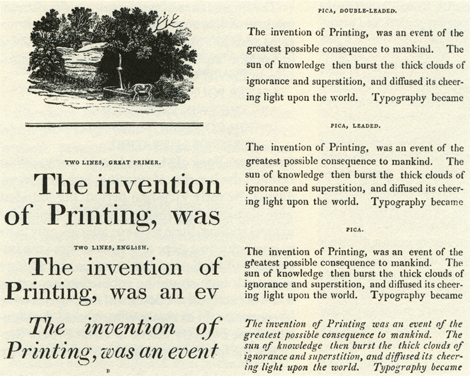
This American type sample catalogue shows that in 1808 using the equivalent of double word spaces between sentences was the style of the day.
The earliest printed example of exaggerated inter-sentence spacing that I could find is a hoary one indeed. Below is a sample from “De Aetna,” by Pietro Bembo (who gave his name to the typeface used in it) and printed by Aldus Manutius (né Teobaldo Manucci) in Venice in 1495.

The spacing used to justify these lines from Bembo’s 1495 work De Aetna is pretty irregular. But the spaces between sentences are much bigger than a single word space, and they carry the brunt of the work of filling out the lines.
Other contemporary printed works—including those by the above Signore Manucci—use “normal” spacing.
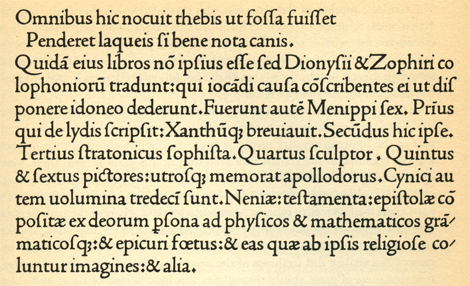
Twenty years before Manutius, the French printer Nicolas Jenson, also working in Venice, used a spacing scheme that looks quite contemporary, with single word spaces applied between sentences.
In the early days of handset type, having the flexibility to exaggerate the spaces between sentences must have been a boon to quickly setting justified type. And Aldus Manutius was famous as a thrifty, profit-conscious printer. He developed what we now call italics as a way to jam more type onto the page to save money on paper. I’m not prepared to aver that double spaces at the ends of sentences arose from crass commercial concerns, but I think it makes a quality rumor, and you can say you saw it here first.
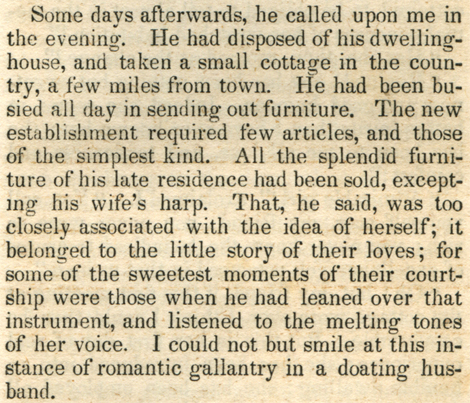
In this 1846 pocket volume for newlywed women, the sentences are as spaced out as the advice. It was printed in Philadelphia.
Styles in all things change, and for reasons that are unclear to me, the habit of double-spacing faded away. As best I can tell from books I’ve looked at, this happened first in continental Europe, followed by the United States.
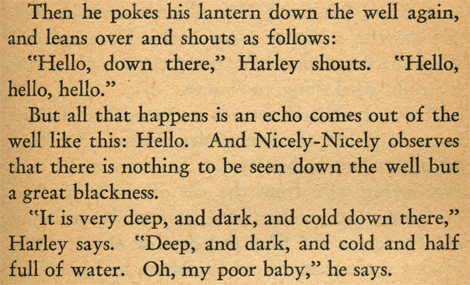
As late as 1941, the practice of using double spaces to separate sentences was still alive in the U.S., as seen in this extract from a Damon Runyon work. Within the following few years, the practice became all but extinct in commercial publishing on American shores.
The English seem to have been the last to join the crowd, with the use of big inter-sentence spaces there continuing at least into the mid-1950s.
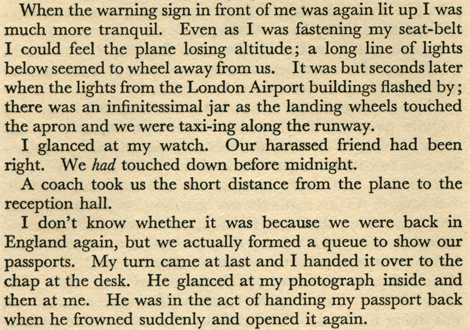
There are surely later survivors of the tradition, but this 1956 edition of the gripping “Airtight Alibi,” printed in London, was the latest I could find that maintained the double-spacing convention.
The Typewriter Connection
On a typewriter, using two word spaces after a period makes sense and is, in fact, typographically the right thing to do. That’s because typewriters use monospaced typefaces, in which every character has the same width. This allows the typewriter to have a simple mechanism for advancing the page as you type, with the carriage (or the typing mechanism) moving a fixed amount after each keystroke, regardless of which character is set: Capitals, lowercase characters, punctuation marks, spaces, everything gets the same escapement (which is the word for that machine movement).
Characters in monospaced typefaces look weird, forced by mechanical necessity onto a Procrustean bed. Some—like the M—look pinched, while others are grossly expanded—such as the i or l. Side bearings for narrow characters, such as punctuation marks, have to be puffed up. The overall effect of such type is very airy and open and its spacing is poorly modulated.

The mechanism for moving the carriage of a typewriter obliged every character to take up the same amount of space on the line, as shown in these monospaced faces. Punctuation—whose shapes can’t be adapted—fares particularly badly. From top to bottom are Courier, Letter Gothic, and Prestige.
So for the same reason that double-spacing typewritten lines is the norm, for monospaced fonts, using two word spaces after periods is too. It’s a question of balancing the white space bound up in each character with the spaces around them. In addition, a single word space simply lacks the visual impact to cue the reader that a sentence has ended. The punctuation mark alone, in short, isn’t enough to punctuate the texture of the type flow.
However, when using proportional typefaces, everything is different. Each character can be designed with its familiar historical proportions and has its own unique width. The texture and color of each line of type is much more even. In these faces, the word space is part of the team, proportioned to work individually, creating a spacing break between sentences that’s neither jarring nor too wimpy.
So there’s no need, except when using monospaced faces, to double the word space after sentences. In fact, good type color and balanced spacing argue against it. But clearly, from a historical perspective, there’s no reason that such doubling should be banned, either. The problem with doing so these days is that it looks like a mistake. We’re not used to seeing these white holes peppering the page, so the wider spaces look inappropriately large.
Interestingly, by the 1960s, electronic phototypesetting systems went as far as ignoring consecutive word spaces altogether when they appeared in text. If the system found consecutive word spaces, it regarded that as a mistake and collapsed them into a single space. For the generation of typesetters who grew up during this regime, this no-nonsense interdiction may be part of the source of the notion that double spaces are not just a bad idea but are in fact verboten.
The Cocktail-Party Summary
Here are the salient points to remember, which you can wheel out against the next type pedant you find yourself stuck beside at a design conference:
- Doubling the word space after a sentence-ending period does not come from the use of typewriters. It was an existing practice that found practical application there.
- If you’re using a typewriter, keep on doubling that space.
- If you’re using a monospaced typeface, do the same, and for the same reasons.
- Modern spacing aesthetics aside, the main reason not to use two word spaces (or an em space) between sentences is that people will think you’re doing it out of ignorance. It will be perceived as a mistake. You may know better, but you’ll have a hard time convincing everyone else.
This article was last modified on September 9, 2022
This article was first published on August 24, 2009




